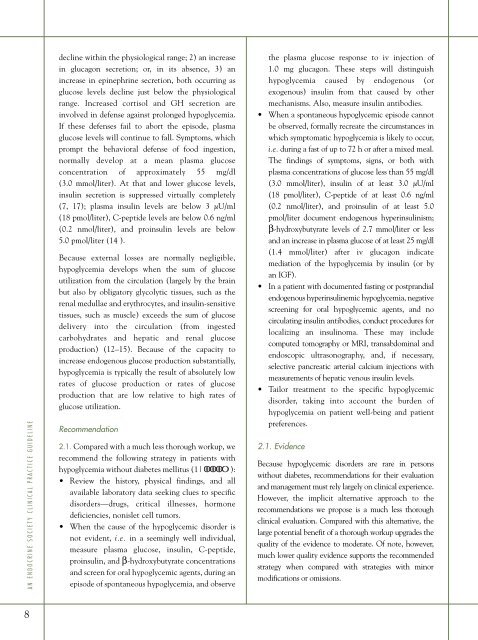Evaluation & Management of Adult Hypoglycemic Disorders
Evaluation & Management of Adult Hypoglycemic Disorders
Evaluation & Management of Adult Hypoglycemic Disorders
You also want an ePaper? Increase the reach of your titles
YUMPU automatically turns print PDFs into web optimized ePapers that Google loves.
AN ENDOCRINE SOCIETY CLINICAL PRACTICE GUIDELINE<br />
8<br />
decline within the physiological range; 2) an increase<br />
in glucagon secretion; or, in its absence, 3) an<br />
increase in epinephrine secretion, both occurring as<br />
glucose levels decline just below the physiological<br />
range. Increased cortisol and GH secretion are<br />
involved in defense against prolonged hypoglycemia.<br />
If these defenses fail to abort the episode, plasma<br />
glucose levels will continue to fall. Symptoms, which<br />
prompt the behavioral defense <strong>of</strong> food ingestion,<br />
normally develop at a mean plasma glucose<br />
concentration <strong>of</strong> approximately 55 mg/dl<br />
(3.0 mmol/liter). At that and lower glucose levels,<br />
insulin secretion is suppressed virtually completely<br />
(7, 17); plasma insulin levels are below 3 µU/ml<br />
(18 pmol/liter), C-peptide levels are below 0.6 ng/ml<br />
(0.2 nmol/liter), and proinsulin levels are below<br />
5.0 pmol/liter (14 ).<br />
Because external losses are normally negligible,<br />
hypoglycemia develops when the sum <strong>of</strong> glucose<br />
utilization from the circulation (largely by the brain<br />
but also by obligatory glycolytic tissues, such as the<br />
renal medullae and erythrocytes, and insulin-sensitive<br />
tissues, such as muscle) exceeds the sum <strong>of</strong> glucose<br />
delivery into the circulation (from ingested<br />
carbohydrates and hepatic and renal glucose<br />
production) (12–15). Because <strong>of</strong> the capacity to<br />
increase endogenous glucose production substantially,<br />
hypoglycemia is typically the result <strong>of</strong> absolutely low<br />
rates <strong>of</strong> glucose production or rates <strong>of</strong> glucose<br />
production that are low relative to high rates <strong>of</strong><br />
glucose utilization.<br />
Recommendation<br />
2.1. Compared with a much less thorough workup, we<br />
recommend the following strategy in patients with<br />
hypoglycemia without diabetes mellitus (1| ):<br />
• Review the history, physical findings, and all<br />
available laboratory data seeking clues to specific<br />
disorders—drugs, critical illnesses, hormone<br />
deficiencies, nonislet cell tumors.<br />
• When the cause <strong>of</strong> the hypoglycemic disorder is<br />
not evident, i.e. in a seemingly well individual,<br />
measure plasma glucose, insulin, C-peptide,<br />
proinsulin, and β-hydroxybutyrate concentrations<br />
and screen for oral hypoglycemic agents, during an<br />
episode <strong>of</strong> spontaneous hypoglycemia, and observe<br />
the plasma glucose response to iv injection <strong>of</strong><br />
1.0 mg glucagon. These steps will distinguish<br />
hypoglycemia caused by endogenous (or<br />
exogenous) insulin from that caused by other<br />
mechanisms. Also, measure insulin antibodies.<br />
• When a spontaneous hypoglycemic episode cannot<br />
be observed, formally recreate the circumstances in<br />
which symptomatic hypoglycemia is likely to occur,<br />
i.e. during a fast <strong>of</strong> up to 72 h or after a mixed meal.<br />
The findings <strong>of</strong> symptoms, signs, or both with<br />
plasma concentrations <strong>of</strong> glucose less than 55 mg/dl<br />
(3.0 mmol/liter), insulin <strong>of</strong> at least 3.0 µU/ml<br />
(18 pmol/liter), C-peptide <strong>of</strong> at least 0.6 ng/ml<br />
(0.2 nmol/liter), and proinsulin <strong>of</strong> at least 5.0<br />
pmol/liter document endogenous hyperinsulinism;<br />
β-hydroxybutyrate levels <strong>of</strong> 2.7 mmol/liter or less<br />
and an increase in plasma glucose <strong>of</strong> at least 25 mg/dl<br />
(1.4 mmol/liter) after iv glucagon indicate<br />
mediation <strong>of</strong> the hypoglycemia by insulin (or by<br />
an IGF).<br />
• In a patient with documented fasting or postprandial<br />
endogenous hyperinsulinemic hypoglycemia, negative<br />
screening for oral hypoglycemic agents, and no<br />
circulating insulin antibodies, conduct procedures for<br />
localizing an insulinoma. These may include<br />
computed tomography or MRI, transabdominal and<br />
endoscopic ultrasonography, and, if necessary,<br />
selective pancreatic arterial calcium injections with<br />
measurements <strong>of</strong> hepatic venous insulin levels.<br />
• Tailor treatment to the specific hypoglycemic<br />
disorder, taking into account the burden <strong>of</strong><br />
hypoglycemia on patient well-being and patient<br />
preferences.<br />
2.1. Evidence<br />
Because hypoglycemic disorders are rare in persons<br />
without diabetes, recommendations for their evaluation<br />
and management must rely largely on clinical experience.<br />
However, the implicit alternative approach to the<br />
recommendations we propose is a much less thorough<br />
clinical evaluation. Compared with this alternative, the<br />
large potential benefit <strong>of</strong> a thorough workup upgrades the<br />
quality <strong>of</strong> the evidence to moderate. Of note, however,<br />
much lower quality evidence supports the recommended<br />
strategy when compared with strategies with minor<br />
modifications or omissions.


